For English version click on “BEITRAG LESEN/READ THE POST” and then scroll to bottom
Nach einem Faulenzertag bei Elly und Werner in Estero Cobulto geht es weiter. Über Cunco und Melipeuco fahren wir zum Wasserfall Traful Traful. Hier sehen wir Spuren der Vulkanausbrüche, denn der Fluß fließt durch Lavagestein. Ein Stück weiter queren wir einen Lavafluss. Am Icalma Lake finden wir erst am Ende des Ortes einen Stellplatz. Die Straßen waren heute zum Teil sehr schlecht. Auffällig sind hier die vielen Araukarien. Auch am nächsten Tag werden die Straßen nicht wirklich besser. In Lonquimay machen wir Mittagspause und einen kurzen Spaziergang dann geht es entlang des Rio BioBio wieder bergauf und bergab. 2 x sehen wir alte zerfallene Brücken, über die wir aber zum Glück nicht müssen. Der Ort Troyo ist zu klein, um einen unauffälligen Stellplatz für uns zu finden. Also fahren wir noch ein Stück weiter und übernachten dann in einer kleinen Kiesgrube neben der Straße. Wie das oftmals ist, sehen wir am nächsten Morgen nur ein Stück später ein paar Plätze, die schöner gewesen wären. Aber immerhin war die Nacht ruhig. Um 11:30h stehen wir dann vor einem Tunnel, der zwar 3,60 m hoch und 3 m breit sein soll, wir haben aber bedenken. Ich gehe in den Tunnel rein und Ralph fährt langsam bis zur Einfahrt vor. Es könnte passen, wäre aber wahrscheinlich Zentimeter- wenn nicht sogar Millimeterarbeit, denn der Untergrund und auch die Wände des Tunnels sind nicht glatt. Wir sehen einige größere Schlaglöcher. Wenn dann unsere Kabine kippt, könnte sie schnell anstoßen. Damit wir aber nicht die 60 km bis Longquimay zurückfahren müssen, wollen wir einen Bogen über die R-785 fahren. Die Straße wird immer enger und bergiger. Nach ca. 15 km kommt uns ein Gaucho mit einer kleinen Herde entgegen. Er sagt uns, dass wir auch auf dieser Straße nur noch ungefähr 20 km weiterfahren können und dann wäre sie gesperrt. Warum haben wir leider nicht verstanden. Nach einer kurzen Mittagspause drehen wir wieder um. Geschafft haben wir rund 3 Stunden reine Fahrzeit und 46 km Strecke. Gegen 19h fängt es an zu regnen. Nach einer ruhigen Nacht geht es auf feuchter, aber gut fahrbarer, Straße weiter Richtung Lonquimay. Dort biegen wir auf die R-89 ab, sind aber erst irritiert, ob sie geöffnet ist, da wir einen Hinweis „Quebrada Las Raises Cerrado“ sehen. Ein Einheimischer sagt aber, dass es ok ist. Anfangs ist die Straße noch geteert, aber dann ist der Belag eine Mischung aus Schotter und Lehm. Kurz bevor wir auf die R-181 kommen, treffen wir auf 2 Radfahrer aus Neuseeland. Wir quatschen ca. 30 Minuten, ehe es weiter geht. Wegen des Regens fahren wir nicht zu dem Wasserfall und der geplante Stellplatz für die Nacht ist zu klein für uns. Also fahren wir weiter bis Curacautin. Hinter dem Busbahnhof ist dort auf einem großen, freien Feld, wo auch ein paar Zirkus- oder Kirmeszelte stehen, genug Platz. Über die R-5 geht es weiter nach Los Ángeles (nein, wir haben uns nicht verfahren). Einen Supermarkt mit passendem Parkplatz für uns finden wir erst im 3. Anlauf. Ralph merkt, dass unser Kühler heiß wird. Auf dem Parkplatz füllen wir 4 Liter Kühlflüssigkeit und 4 Liter Wasser auf. Wir fahren noch ca. 30 km weiter bis zu einer Copec Tankstelle und parken hinter dem Santiärblock & Bistro und nutzen die sehr sauberen Duschen. Die Nacht ist durch viele Trucks etwas unruhig und unser Auto erregt mal wieder viel Aufmerksamkeit. Wir müssen auch wieder Wasser nachfüllen. Kein gutes Zeichen. Weiter geht es über die R5 zu den Saltos del Laja. Die Suche nach einem Campingplatz erweist sich als schwieriger als gedacht. Entweder sind sie sehr teuer, haben kein Camping mehr (nur noch Tagesgäste) oder haben nur am Wochenende geöffnet. Bei Don Ambrosio werden wir aber fündig. Er hat zwar zurzeit auch keine Stellplätze mehr (plant aber, in den nächsten Jahren einen Platz für ein paar mehr oder weniger autarke Wohnmobile mit entsprechendem Angebot (Ver- und Entsorgungsstation) zu bauen), wir dürfen aber trotzdem bleiben und können unser WC in einer Grube entleeren. Wir laufen ein bisschen durch die schöne Anlage mit Cabanas und einem kleinen „Zoo“, sind aber wegen der Hitze ansonsten eher faul. Am Morgen gehen wir zu Fuß zu den Saltos. Hin und zurück sind das ca. 5,5 km. Entlang des Weges zu den Wasserfällen stehen jede Menge Buden mit Klamotten, Kunsthandwerk und Essen. Letztlich bieten sie aber doch alle das Gleiche an. Am Montag versucht Oliviers (so heißt Don Ambrosio) für uns bei Mercedes Kaufmann anzurufen, kommt aber nicht durch. Um 10h fahren wir auf gut Glück zurück nach Los Ángeles. Dort haben wir den klassischen Vorführeffekt. Der Kühler ist dicht und hat kein Wasser mehr verloren. Der Mechaniker schaut sich das aber genau an und findet ein Loch im Kühler. Da es diesen Kühler in ganz Chile nicht gibt, wird er ausgebaut und zur Reparatur geschickt. Mittags werden wir zum Essen in die hauseigene Kantine eingeladen. Um 15h fährt der Mog aus der Halle und um 17:30h bekommen wir ihn repariert und mit gesäubertem Führerhaus zurück. Bezahlt haben wir CLP 186.890 (etwa €210 ). Auf dem Weg zurück zu Don Ambrosio umfahren wir die Mautstelle. Das hat sich aber nicht gelohnt, da wir knapp 10 km Schotter fahren müssen und fast 15 Minuten länger brauchen.
English Version (no translation of German text)
After a lazy day with Elly and Werner in Estero Cobulto we continue our journey. Via Cunco and Melipeuco we drive to the waterfall Traful Traful. Here we see traces of the volcanic eruptions, because the river flows through lava rock. A bit further we cross a lava river. At Icalma Lake we only find a place for the night out of town. The roads were partly very bad today. The many araucarias are conspicuous here. The roads don’t really get better when we continue in the morning. In Lonquimay we stop for a lunch break and go for a short walk and then we continue along Rio BioBio. The road is uphill and downhill again. 2 times we see old decayed bridges, but fortunately we don’t have to cross them. The town of Troyo is too small to find an inconspicuous overnight place for us. Therefore, we drive a bit further and then spend the night in a small gravel pit next to the road. As it often is, we see a few places that would have been nicer when we move on in the morning. But at least the night was quiet. At 11:30h we are forced to stop in front of a tunnel, which is supposed to be 3.60m high and 3m wide, but we have our doubts. I go into the tunnel and Ralph slowly drives toward the entrance. It could fit, but would probably be centimeter if not millimeter work, because the ground and also the walls of the tunnel are not smooth. We see some larger potholes. If our cabin then tilts, it could quickly bump. In order to not have to drive the 60 km back to Longquimay, we decide to take a curve over R-785. The road becomes more and more narrow and mountainous. After about 15 km a gaucho with a small herd comes towards us. He tells us that we can only continue on this road for about 20 km and then it would be closed. Unfortunately, we did not understand why. After a short lunch break, we turn around again. We have managed about 3 hours of pure driving time and 46 km of distance. Around 19h it starts to rain. After a quiet night we continue on a damp, but well drivable road towards Lonquimay. There we turn onto the R-89, but are first irritated if it is open, because we see a sign „Quebrada Las Raises Cerrado“. But a local says that it is ok. At the beginning the road is still tarred, but then the surface is a mixture of gravel and clay. Shortly before we get on the R-181, we meet 2 cyclists from New Zealand. We chat for about 30 minutes before we continue. Because of the rain we don’t go to the signposted waterfall and the planned site for the night is too small for us. Therefore, we drive on to Curacautin. Behind the bus station there is enough space on a large open field, where there are also a few circus or fairy tents. Via R-5 we continue to Los Ángeles (no, we did not get lost). It takes us 3 attempts to find a supermarket with a suitable parking lot for us. Ralph notices that our radiator is getting hot. At the parking lot we fill up 4 liters of coolant and 4 liters of water. We drive about 30 km further to a Copec gas station and park behind the sanitary block & bistro and use the very clean showers. The night is a bit restless because of many trucks and our car attracts a lot of attention again. We also have to refill water again. Not a good sign. We continue on R-5 to Saltos del Laja. The search for a campground turns out to be more difficult than expected. Either they are very expensive, have no camping anymore (only day guests) or are only open on weekends. But we find one at Don Ambrosio. He doesn’t offer camping anymore (but plans to build a place for a few more or less self-sufficient campers with appropriate offer (supply and disposal station) in the next few years), but we still can stay and empty our toilet in a pit. We walk a bit through the beautiful complex with cabanas and a small „zoo“, but are otherwise rather lazy because of the heat. In the morning we walk to the waterfalls. The whole round trip is about 5.5 km. Along the road are a lot of stalls with clothes, handicrafts and food. But in the end, they all offer the same things. On Monday, Olivier (that’s Don Ambrosio’s name) tries to call Mercedes Kaufmann for us, but doesn’t get through. At 10am we drive back to Los Ángeles on the off chance to get a slot at the workshop. There we experience the classic demonstration effect. The radiator is tight and has lost no more water. But the mechanic takes a closer look and finds a hole. Since this radiator is not available in all of Chile, it is removed and sent for repair. At noon we are invited to eat in the in-house canteen. At 15h the Mog leaves the hall and at 17:30h we get it back repaired and with a cleaned cab. We paid CLP 186.890 (about € 210). On the way back to Don Ambrosio we bypass the tollbooth. But that was not worth it, because we have to drive almost 10 km gravel and need almost 15 minutes longer.



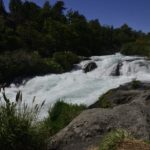



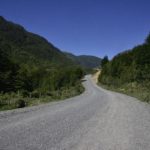

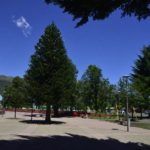









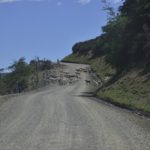
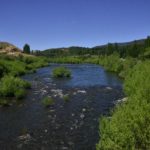

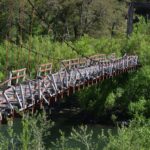






























Schreibe den ersten Kommentar